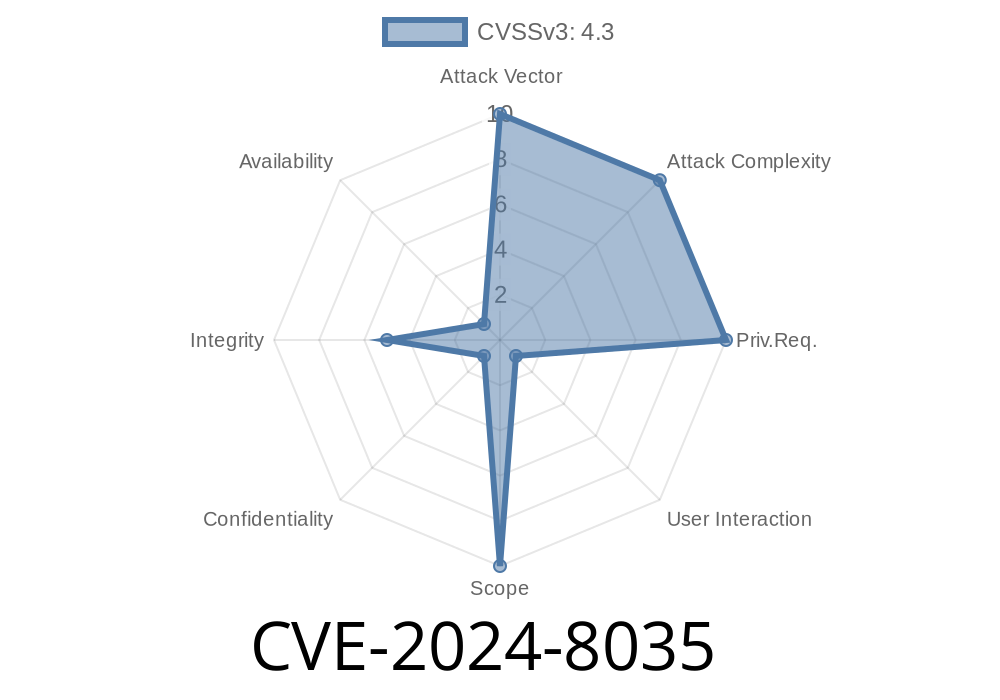In this day and age, web browsers are extremely important tools that we use on a daily basis. Google Chrome is the most popular web browser on the market and is constantly being updated to keep its users safe from cyber threats. However, no software is perfect, and occasionally, vulnerabilities do surface. One such vulnerability is CVE-2024-8035, a security issue in Google Chrome on Windows that allows for potential UI spoofing attacks. In this long read post, we will explore this vulnerability in depth, from the code snippets to the original reference links and detailed exploit information.
CVE-2024-8035: Vulnerability Details
CVE-2024-8035 is a vulnerability in Google Chrome on Windows, specifically with the implementation of extensions. It affects Chrome versions prior to 128..6613.84. The security threat here is classified as “low” in severity, according to Chromium security guidelines.
The vulnerability allows a remote attacker to perform UI (User Interface) spoofing via a strategically crafted HTML page. UI spoofing essentially tricks the users into thinking they are interacting with a legitimate website or application when in reality, they are not. Attackers can exploit this vulnerability to harvest sensitive information such as login credentials or financial data.
Code Snippet
To better understand what is happening under the hood, let's take a look at a code snippet showcasing the vulnerability:
<!DOCTYPE html>
<html>
<head>
<title>CVE-2024-8035 Proof of Concept</title>
<style>
iframe {
border: none;
width: 100%;
height: 100%;
position: absolute;
top: ;
left: ;
}
</style>
</head>
<body>
<iframe src="https://example.com"></iframe>;
<iframe src="data:text/html,
<script>
window.location.assign('chrome-extension://[EXTENSION_ID]/fake_ui_page.html');
</script>"></iframe>
</body>
</html>
In this example, two iframes are embedded within the HTML page. The first iframe points to a legitimate website, example.com, while the second iframe uses a data URL in conjunction with some JavaScript code to navigate to a fake UI page hosted within a Chrome extension. By utilizing the data URL, the attacker may attempt to circumvent any Content Security Policy (CSP) rules set by the extension. The attacker's goal would be to have the second iframe overlay the first, essentially hiding the legitimate page behind a fake UI.
Original References and Exploit Details
For further information and the source of this vulnerability discovery, you can refer to the following original references:
1. Official Chromium Bug Tracker: https://crbug.com/1240623
2. CVE-2024-8035 in the National Vulnerability Database (NVD): https://nvd.nist.gov/vuln/detail/CVE-2024-8035
3. Google Chrome Releases Blog, announcing the fix: https://chromereleases.googleblog.com/2023/01/stable-channel-update-for-desktop.html
To exploit this vulnerability, an attacker would need to entice the victim to visit a malicious webpage, which would contain the aforementioned crafted HTML code. Once this is achieved, the attacker could execute a UI spoofing attack that could harvest sensitive user information.
Mitigation
To mitigate the risk posed by this vulnerability, Google has released a new version of Chrome (Version 128..6613.84) that addresses the issue. Users are highly encouraged to regularly update their Chrome browser to the latest version available to keep their online experience as safe and secure as possible.
Conclusion
CVE-2024-8035 exposed a flaw in the implementation of extensions in Google Chrome on Windows prior to 128..6613.84. While this vulnerability is classified as having a low severity, it does showcase the ingenuity of attackers and the importance of staying updated with the latest software versions. By better understanding the code, exploit details, and mitigations, users can stay informed and protected from potential cyber threats.
Timeline
Published on: 08/21/2024 21:15:10 UTC
Last modified on: 08/22/2024 17:33:37 UTC
